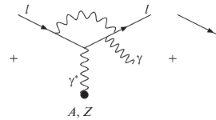Abstract
In this paper we examine the theoretical foundations underlying the testing of quantum electrodynamics. We show that for the photon propagator (together with the contiguous vertices) it is not necessary to introduce ad hoc modifications in sufficiently accurate scattering experiments. Energy, momentum transfer, and accuracy determine the tested length in a model-independent way. The situation is quite different with the electron propagator. If gauge invariance is taken for granted, the electron propagator cannot be tested with processes where diagrams with open electron lines are important in the lowest order of perturbation theory. These processes can only give limits for anomalous moment and multiphoton parts of the vertices. On the other hand, processes with closed electron loops (vacuum polarization), such as photon-photon and Delbrück scattering, as well as photon splitting or corresponding low-energy, high-precision experiments can give limits also for the electron propagator. But in these cases only less accurate limits can be obtained, which depend on the modification model. Hence testing of the electron propagator, i.e., roughly speaking, the Dirac equation, is much more difficult than testing of the photon propagator, i.e, Maxwell's equations.
Similar content being viewed by others
References
H. Salecker,Z. Naturf. 8a, 16 (1953);10a, 349 (1955).
S. D. Drell,Ann. Phys. (NY) 4, 75 (1958).
H. Salecker,Z. Phys. 160, 385 (1960).
L. Davis, Jr., A. S. Goldhaber, and M. M. Nieto,Phys. Rev. Lett. 35, 1402 (1975).
E. Kazes,Nuovo Cimento 13, 1226 (1959); K. Nishijima,Phys. Rev. 119, 485 (1960); N. P. Chang and H. S. Mani,Phys. Rev. B 134, 896 (1964).
N. M. Kroll,Nuovo Cimento 45A, 65 (1966).
K. Ringhofer,Acta Phys. Austr. 31, 67 (1970).
N. Liebsch, Thesis on photon-photon scattering and testing of quantum electrodynamics, University of Munich (1974), to be published.
J. Kraus,Nucl. Phys. B 89, 133 (1975).
H. Schneider and H.-D. Steinhöfer, Thesis on photon splitting and testing of quantum electrodynamics, University of Munich (1975), to be published.
H. Salecker, Proposal of new experiments for testing quantum electrodynamics, Paper presented at the 19th International Conference on High Energy Physics, Tokyo (1978); T. Anders, Y. Sakurayama, and H. Salecker, to be published.
M. Magg, K. Ringhofer, and H. Salecker,Nucl. Phys. B 40, 367 (1972).
B. L. Beronet al., Phys. Rev. D 17, 2187, 2839 (1978); E. Hilgeret al., Phys. Rev. D 15, 1809 (1977); see also R. Hofstadter, inProc. of the 1975 International Symposium on Lepton and Photon Interactions at High Energies (Stanford University), p. 869.
J. Baileyet al., Phys. Lett. 67B, 225 (1977).
Ch. Bergeret al. (Pluto Collaboration), Test of qed in the reactionse + e − →e + e − ande + e − → μ+μ− at cms energies from 9.4 to 31.6 Gev. DESY 80/01. Submitted toZ. Physik C.
Author information
Authors and Affiliations
Additional information
Dedicated to the memory of Prof. Wolfgang Yourgrau (1908–1979).
Rights and permissions
About this article
Cite this article
Ringhofer, K., Salecker, H. What can be tested in quantum electrodynamics?. Found Phys 10, 185–196 (1980). https://doi.org/10.1007/BF00715066
Received:
Issue Date:
DOI: https://doi.org/10.1007/BF00715066



